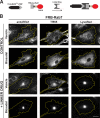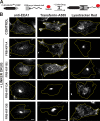A novel assay reveals preferential binding between Rabs, kinesins, and specific endosomal subpopulations
- PMID: 25624392
- PMCID: PMC4315250
- DOI: 10.1083/jcb.201408056
A novel assay reveals preferential binding between Rabs, kinesins, and specific endosomal subpopulations
Abstract
Identifying the proteins that regulate vesicle trafficking is a fundamental problem in cell biology. In this paper, we introduce a new assay that involves the expression of an FKBP12-rapamycin-binding domain-tagged candidate vesicle-binding protein, which can be inducibly linked to dynein or kinesin. Vesicles can be labeled by any convenient method. If the candidate protein binds the labeled vesicles, addition of the linker drug results in a predictable, highly distinctive change in vesicle localization. This assay generates robust and easily interpretable results that provide direct experimental evidence of binding between a candidate protein and the vesicle population of interest. We used this approach to compare the binding of Kinesin-3 family members with different endosomal populations. We found that KIF13A and KIF13B bind preferentially to early endosomes and that KIF1A and KIF1Bβ bind preferentially to late endosomes and lysosomes. This assay may have broad utility for identifying the trafficking proteins that bind to different vesicle populations.
© 2015 Bentley et al.
Figures





References
-
- Banker G., and Goslin K.. 1998. Culturing Nerve Cells. Second edition MIT Press, Cambridge, MA: 666 pp.
Publication types
MeSH terms
Substances
Grants and funding
LinkOut - more resources
Full Text Sources
Other Literature Sources
Research Materials

